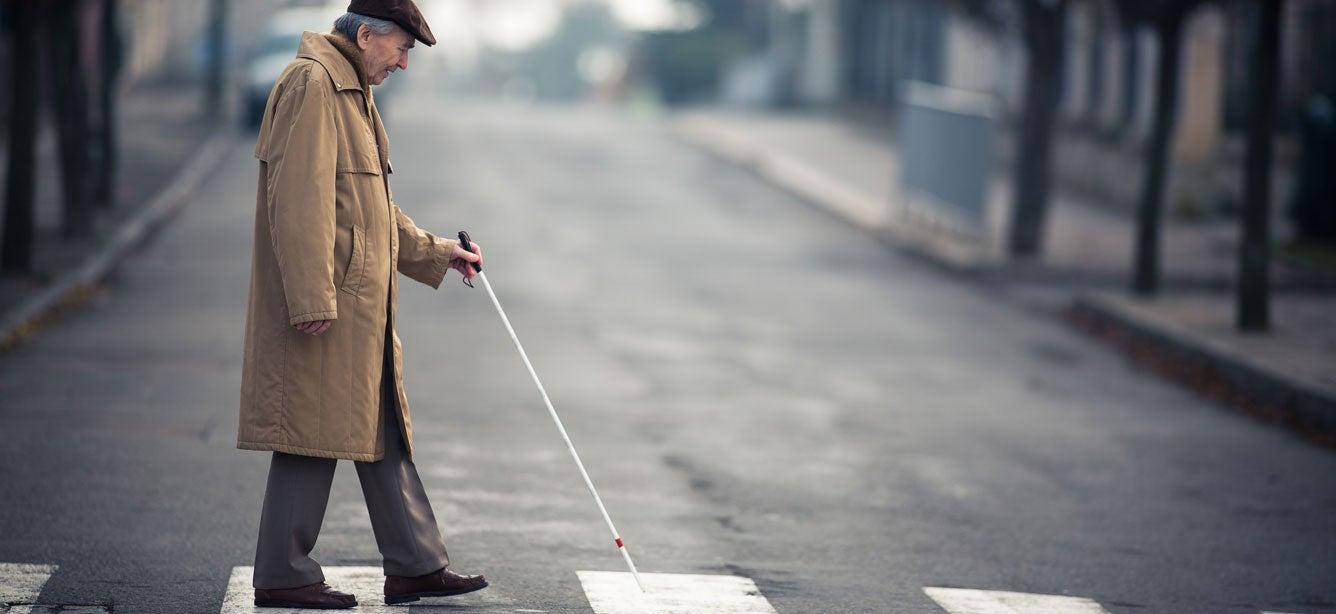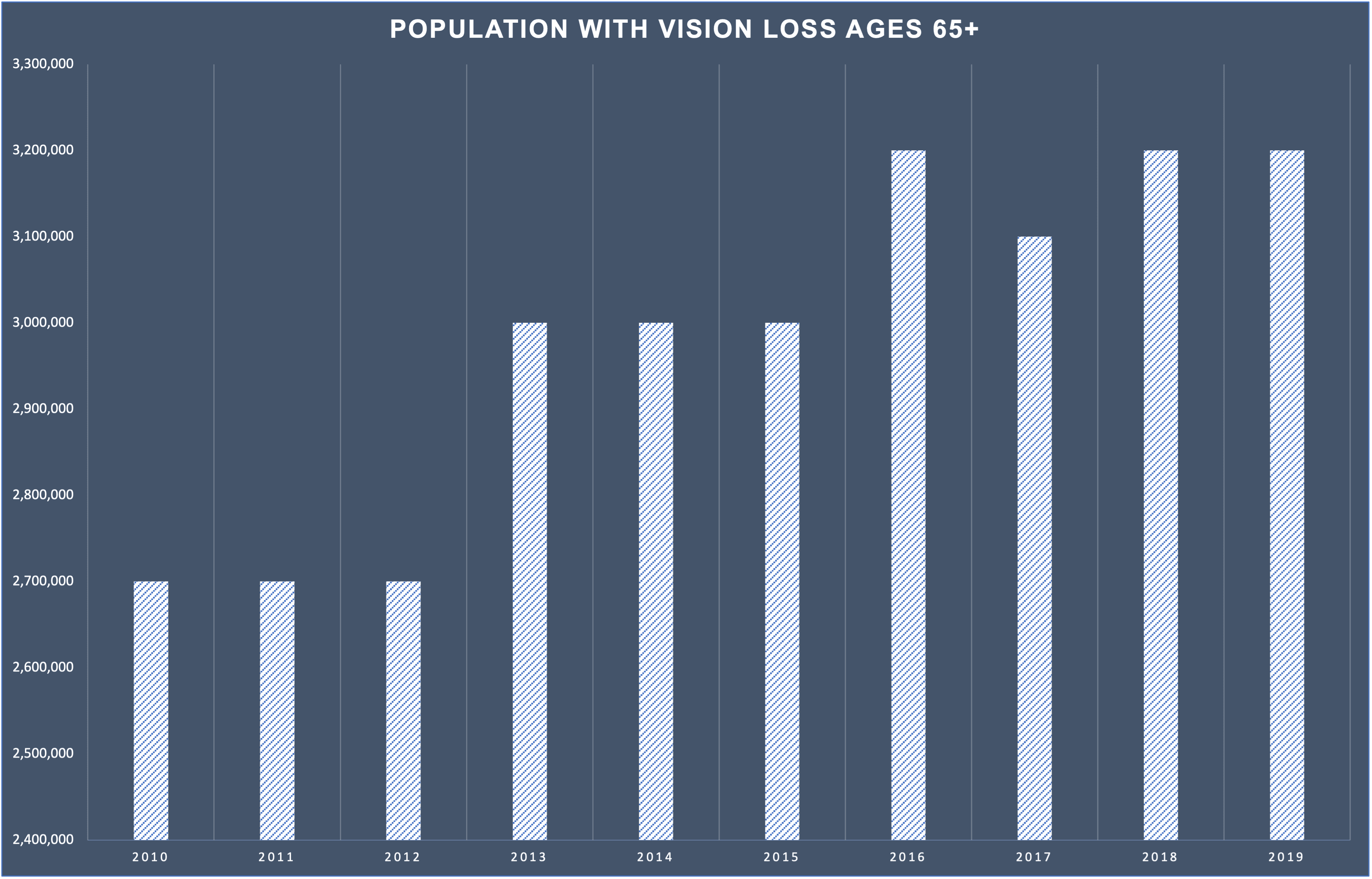
Related Topics
Vision loss is a growing challenge for older Americans. According to the American Foundation for the Blind, 3.2 million people—age 65 and older—experienced visual impairment in 2019.

However, it is important to note that although the eye ages along with the body and some vision changes occur, visual impairment is not a normal part of aging.
Some common signs indicating an eye condition impacting vision include:
- Frequent inability to find common items like the TV remote or other items that might just get laid around
- Bumping into people or things
- Difficulty or inability to read clearly; and
- Difficulty recognizing people they know.
These might be attributed to other age-related issues or diseases, however, it is important to rule out vision impairment as the cause. Most eye diseases are progressive, and vision continues to deteriorate, thus impacting functioning even more. Early diagnosis can increase access to treatment that prolongs vision and can help an individual develop important coping strategies and resources.
Vision loss and learning to adjust to it not only impacts the individual with the visual impairment, it impacts everyone in their life in some way. There are implications for safety, daily independent living, medication management, transportation, and almost every aspect of life. Loved ones may become caregivers. But, it is so important to know that a person with low vision, and even those who experience significant vision loss, can learn strategies to safely and independently perform many daily tasks.
Signs your loved one may be experiencing vision loss
- Misplacing common items such as the phone, television remote control or eye glasses
- Wearing mismatched or stained clothing
- Frequently spilling liquids or food
- Not recognizing people
- Stumbling or tripping over steps
- Calling the wrong telephone number often
- Signing off of the line on paper documents
Although this list is not comprehensive, these are some of the common signs of a decline in vision and a serious eye condition. You might have thought these are just signs that you or your loved one are getting forgetful, or even developing dementia. However, it could be vision loss.
Many eye conditions cause varying degrees of visual impairment and may initially impact just a few areas of a persons life. In fact, it can be very confusing because a person with one of these conditions may have no difficulty doing one task, while having extreme difficulty doing another. It is all about the type and severity of the eye condition. For example, a person with Macular Degeneration, which impacts central vision, may not recognize a family member but be able to pick up a safety pin off of the floor.
There are many other signs, and if you suspect you or a loved one has a visual impairment it is important to see an ophthalmologist for a thorough dilated exam.
Therefore, the first step in this journey is getting a diagnosis and finding out what is causing the vision loss, the prognosis, and how vision is impacted.
Once you have a diagnosis, together you can work to understand the condition and the functional implications, or how the condition will impact independence and safety. Help is available and a person with a visual impairment, even one with total blindness can learn adaptive techniques to live alone, cook, keep their home clean, use a computer and phone, travel independently, and work. To find low cost or free services for those 55 and older, visit TimeToBeBold.org for a list of resources available in your community. These services are provided by the Department of Education Rehabilitation Services Administration.
Many family members feel they must take their loved one with a visual impairment into their home and become their caregiver. No one wants to be dependent or a burden on their family, and if the decision is made that the individual will move in with their loved one, this does not mean they cannot actively contribute to the home and their own well-being. Additional help may be needed, such as help getting groceries and getting to appointments, organizing medications, and checking for stains on clothes, but with the right training and tools an older person with a visual impairment can certainly remain in their home or be an active part of the household responsibilities if living with a family member.
Promoting independence in the house
We all know it is often difficult to live with someone else. We all have levels of cleanliness, organization and routines. One of the most important things for safety and independent living for a person with a visual impairment is the creation of solid organization systems.
Helpful adaptations to make for someone with a visual impairment:
- De-clutter. Everyone benefits from a clutter free organized space, but none more than a person with vision loss. It is hard to organize a space when there are many non-essential items.
- Help get everything organized. Being well-organized is probably the most important thing a person with low vision or blindness can do. Everything should have a specific place and always be put back in that spot. Too often people with visual impairments are assumed to have memory issues or dementia if they can’t find things. As a person who can see, you can enter a room and scan it to locate items like the television remote control. If your vision is impaired you will either spend a lot of time searching for the possible places it could be or keep it in one designated spot. This tip includes refrigerator organization!
- Do not move the furniture without asking and providing an orientation to the changes. Think about how many of us get up at night to go to the bathroom and do not turn on the lights. You know the path. But, if someone moves the furniture you might bump into something. The same principle applies here. A person learns where things are and counts on it being that way.
- If it helps, change the lighting to ensure the best light for the individual. There is no one right answer or light source as it really depends on the person.
- Use contrast if it helps. For example: Put a dark rug on a light colored tile floor at the location where a step is, use a light colored coffee mug for coffee, or put a dark colored place mat under the plate at the table.
- Use labeling and marking strategies. For example: Put a small rubber band around the conditioner if the shampoo feels and looks the same, put a raised dot on the 350 degrees of the oven knob, put a raised dot on the start button and 1 minute of the microwave, put a bright colored mark on the 5 on the telephone, etc. There is no rule, except don’t over label or over mark. Be creative and find adaptations that work in your home.
- Consider a medical alert system. Medical alert systems are good options for individuals seeking independent living but who also want the peace of mind of emergency response if needed. Many medical alert systems with fall detection provide an added level of safety, particularly for older adults with vision loss.
It is important to know that, you, as the individual with the visual impairment or as a loved one, are not alone. Find the information and resources that can help the entire family move forward safely and confidently.
Resources
1. Independent Living Older Individuals who are Blind Technical Assistance Center. (2021). Lessons for Living. Found on the Internet at OIB-TAC.org
2. American Printing House for the Blind. (2021). Getting Started 2020: A Guide for People New to Vision Loss - VisionAware. Found on the Internet at https://visionaware.org/getting-started/
3. Specialized services and training available for individuals 55 and older with low vision and blindness. Found on the Internet at OIB-TAC.org or TimeToBeBold.org



